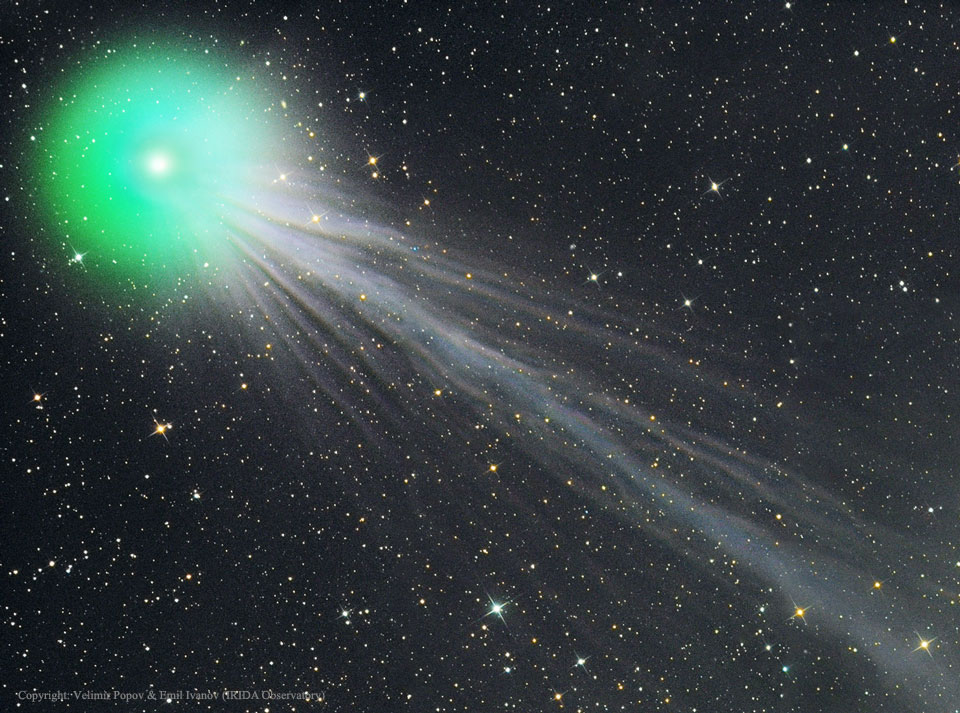Nice pics nada & 12icer.
 |
 |
|
|||||||||||
 |
 |
||||||||||||
|
|
|
|
|
|
|
||||||||
 |
|
|
|
|
|
 |
|||||||
|
|
|
|
|||||||||||
|
|
|||||||||||||
|
|
|
|
|
|
|
|
|
|
|
|
|
|
|
Results 31 to 40 of 528
Thread: Space Pics v.3
-
01-04-2015, 10:11 PM #31
-
01-07-2015, 02:08 AM #32
Galactic Wheels within Wheelssig13-004_Inline.jpg
How many rings do you see in this striking new image of the galaxy Messier 94 (NGC 4736) as seen by the infrared eyes of NASA’s Spitzer Space Telescope? While at first glance one might see a number of them, astronomers believe there is just one.
Historically, Messier 94 was considered to have two strikingly different rings: a brilliant, compact band encircling the galaxy’s core, and a faint, broad, swath of stars falling outside its main disk.
Astronomers have recently discovered that the outer ring, seen here in the deep blue glow of starlight, may actually be more of an optical illusion. Their 2009 study combined infrared Spitzer observations with ultraviolet data from NASA’s Galaxy Evolution Explorer, and ground-based surveys in visible (Sloan Digital Sky Survey) and near infrared light (Two Micron All Sky Survey). This more complete picture of Messier 94 indicates that we are really seeing two separate spiral arms that, from our perspective, take on the appearance of a single, unbroken ring.
The bright inner ring of Messier 94 is very real, however. This area is sometimes identified as a “starburst ring” because of the frenetic pace of star formation in this confined area. Starbursts like this can often be triggered by gravitational encounters with other galaxies, but in this case may instead be caused by the galaxy’s oval shape.
Tucked in between the inner starburst ring and the outer ring-like arms we find the galaxy’s disk, striated with greenish filaments of dust. While, at first glance, these dusty arcs look like a collection of rings, they actually follow tightly wound spiral arcs.
Messier 94 is about 17 million light years away, making it a distant neighbor of our own Milky Way galaxy. It was first discovered by Charles Messier’s assistant, Pierre Méchain, in 1781 and was added to his supervisor’s famous catalog two days later.
Infrared light with wavelengths of 3.6 and 4.5 microns is shown as blue/cyan, showing primarily the glow from starlight. 8 micron light is rendered in green, and 24 micron emission is red, tracing the cooler and warmer components of dust, respectively. The observations were made in 2004, before Spitzer ran out of cryogen.
-
01-07-2015, 02:12 AM #33
Taken Under the "Wing" of the Small Magellanic Cloudsig13-002_Inline.jpg
New Chandra observations have been used to make the first detection of X-ray emission from young stars with masses similar to our Sun outside our Milky Way galaxy. The Chandra observations of these low-mass stars were made of the region known as the "Wing" of the Small Magellanic Cloud (SMC), one of the Milky Way's closest galactic neighbors. In this composite image of the Wing the Chandra data is shown in purple, optical data from the Hubble Space Telescope is shown in red, green and blue and infrared data from the Spitzer Space Telescope is shown in red. Astronomers call all elements heavier than hydrogen and helium - that is, with more than two protons in the atom's nucleus - "metals". The Wing is a region known to have fewer metals compared to most areas within the Milky Way. The Chandra results imply that the young, metal-poor stars in NGC 602a produce X-rays in a manner similar to stars with much higher metal content found in the Orion cluster in our galaxy.
-
01-13-2015, 08:20 PM #34
sig14-010a_Inline.jpgAstronomers have found cosmic clumps so dark, dense and dusty that they throw the deepest shadows ever recorded. The clumps, shown here in a zoom-in detail, were discovered within a huge cosmic cloud of gas and dust. Infrared observations from NASA's Spitzer Space Telescope of these blackest-of-black regions in the cloud paradoxically light the way to understanding how the brightest stars form.
A new study takes advantage of the shadows cast by these dark clumps to measure the cloud's overall structure and mass. These dense, clumpy pockets of star-forming material within the cloud are so thick with dust that they scatter and block not only visible light, but almost all background infrared light as well.
The dusty cloud, the results suggest, will likely evolve into one of the most massive young clusters of stars in our galaxy. The densest clumps will blossom into the cluster's biggest, most powerful stars, called O-type stars, the formation of which has long puzzled scientists. These hulking stars have major impacts on their local stellar environments while also helping to create the heavy elements needed for life.
This image reveals the overall darkness of the cloud, calculated using Spitzer's infrared observations at a wavelength of 8 microns. Artifacts left by individual stars have been removed from the data, though several large, particularly bright areas have left white artifacts in the cloud map.
-
01-22-2015, 04:55 AM #35
ssc2014-01a_Inline.jpgThis graphic shows the evolutionary sequence in the growth of massive elliptical galaxies over 13 billion years, as gleaned from space-based and ground-based telescopic observations. The growth of this class of galaxies is quickly driven by rapid star formation and mergers with other galaxies.
-
01-22-2015, 04:59 AM #36
sig13-014_Inline.jpghe Ghost of Jupiter, also known as NGC 3242, is located roughly 1,400 light-years away in the constellation Hydra. Spitzer's infrared view shows off the cooler outer halo of the dying star, colored here in red. Also evident are concentric rings around the object, the result of material being periodically tossed out in the star's final death throes.
In this image, infrared light at wavelengths of 3.6 microns is rendered in blue, 4.5 microns in green, and 8.0 microns in red.
-
01-30-2015, 03:38 AM #37
ssc2013-07a_Inline.jpgssc2013-07a_Inline.jpgThe spectacular swirling arms and central bar of the Sculptor galaxy are revealed in this new view from NASAs Spitzer Space Telescope. The main image is an infrared composite combining data from two of Spitzers detectors taken during its early cold, or cryogenic, mission.
Also known as NGC 253, the Sculptor galaxy is part of a cluster of galaxies visible to observers in the Southern hemisphere. It is known as a starburst galaxy for the extraordinarily strong star formation in its nucleus. This activity warms the surrounding dust clouds, causing the brilliant yellow-red glow in the center of this infrared image.
The image is split into two constituent parts on the right. On the top is a blue glow primarily from the light of stars as seen at the shorter wavelengths of infrared light. In this view, the disk, spiral arms and central bar are much easier to identify than in visible light because the obscuring effects of dust are minimized.
The lower right image shows the glow of dust at longer infrared wavelengths in green and red. Regions of star formation glow especially bright at the longest wavelengths (red).
While Spitzer is now operating without any onboard cryogen, it can still operate its shorter-wavelength detectors to produce images equivalent to the star map on the upper right. Spitzer continues to be a valuable tool for studying the infrared properties of galaxies near and far.
Infrared light with wavelengths of 3.6 and 4.5 microns is shown as blue/cyan. Eight-micron light is rendered in green, and 24-micron emission is red.
-
01-31-2015, 09:10 PM #38

The Complex Ion Tail of Comet Lovejoy
What causes the structure in Comet Lovejoy's tail? Comet C/2014 Q2 (Lovejoy), which is currently at naked-eye brightness and near its brightest, has been showing an exquisitely detailed ion tail. As the name implies, the ion tail is made of ionized gas -- gas energized by ultraviolet light from the Sun and pushed outward by the solar wind. The solar wind is quite structured and sculpted by the Sun's complex and ever changing magnetic field. The effect of the variable solar wind combined with different gas jets venting from the comet's nucleus accounts for the tail's complex structure. Following the wind, structure in Comet Lovejoy's tail can be seen to move outward from the Sun even alter its wavy appearance over time. The blue color of the ion tail is dominated by recombining carbon monoxide molecules, while the green color of the coma surrounding the head of the comet is created mostly by a slight amount of recombining diatomic carbon molecules. The featured three-panel mosaic image was taken nine days ago from the IRIDA Observatory in Bulgaria. Comet Lovejoy made it closest pass to the Earth two weeks ago and will be at its closest to the Sun in about ten days. After that, the comet will fade as it heads back into the outer Solar System, to return only in about 8,000 years.
Image Credit & Copyright: Velimir Popov & Emil Ivanov (IRIDA Observatory)
-
02-05-2015, 05:18 AM #39

M104: The Sombrero Galaxy
The striking spiral galaxy M104 is famous for its nearly edge-on profile featuring a broad ring of obscuring dust lanes. Seen in silhouette against an extensive bulge of stars, the swath of cosmic dust lends a broad brimmed hat-like appearance to the galaxy suggesting the more popular moniker, The Sombrero Galaxy. Hubble Space Telescope and ground-based Subaru data have been reprocessed with amateur color image data to create this sharp view of the well-known galaxy. The processing results in a natural color appearance and preserves details often lost in overwhelming glare of M104's bright central bulge when viewed with smaller ground-based instruments. Also known as NGC 4594, the Sombrero galaxy can be seen across the spectrum and is thought to host a central supermassive black hole. About 50,000 light-years across and 28 million light-years away, M104 is one of the largest galaxies at the southern edge of the Virgo Galaxy Cluster.
Image Data: NASA, ESO , NAOJ, Giovanni Paglioli - Processing: R. Colombari
-
02-05-2015, 04:42 PM #40iptv












- Join Date
- Dec 2014
- Location
- Somewhere on planet Earth....... I think
- Posts
- 785
- Rep Power
- 45
Simply Amazing !!!
Similar Threads
-
RCU model pics
By crazed 9.6 in forum BuzzTV RemotesReplies: 25Last Post: 01-05-2024, 10:41 PM -
BuzzTV e1 - pics
By Ryu in forum BuzzTV EssentialsReplies: 0Last Post: 02-01-2021, 01:06 AM -
Zx Pics
By Capt.Kangaroo in forum Formuler ZxReplies: 17Last Post: 09-21-2018, 02:38 PM -
Space News/UFO's Etc...(Discussion/Pics/Vids)
By Capt.Kangaroo in forum Deep SpaceReplies: 678Last Post: 05-10-2018, 12:27 PM -
This is cool pics
By Marley in forum Chit Chat LoungeReplies: 0Last Post: 03-06-2018, 06:41 PM




 Reply With Quote
Reply With Quote
